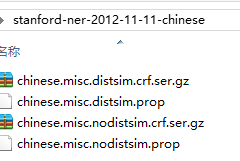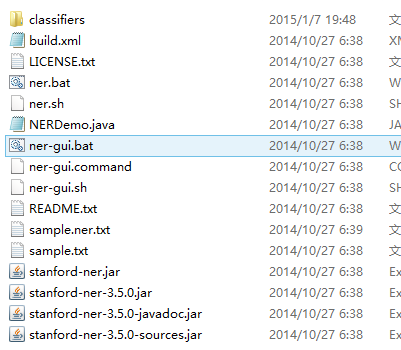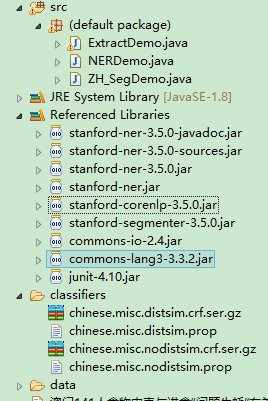热门标签
热门文章
- 1Mars3D手把手开发教程(vue3)
- 2百度生成式AI产品文心一言邀请测试,五大场景、五大能力革新生产力工具_生成式ai场景还是多模态情感生成
- 3市值216亿芯片股收监管工作函;工信部将采取举措推动算力发展;文心大模型3.5能力已超ChatGPT 3.5丨每日大事件...
- 4数电实验74151芯片
- 5华为VRP目录和文件操作实验
- 6【STM32单片机+DHT11温度传感器】快速上手,适用于多种型号芯片_32+dht11
- 7“老司机”和你聊聊云数据库系统容灾那些事
- 8数字城市:智慧水库(泉舟时代)_福建泉舟时代
- 9微信小程序获取用户信息(getUserProfile接口回收后)——通过头像昵称填写获取用户头像和昵称_uni.getuserprofile被收回了
- 10js判断radio是否被选中(一)_js判断radio是否选中
当前位置: article > 正文
使用Stanford Word Segmenter and Stanford Named Entity Recognizer (NER)实现中文命名实体识别_standord ner 示例代码
作者:Gausst松鼠会 | 2024-05-22 21:54:38
赞
踩
standord ner 示例代码
一、分词介绍
斯坦福大学的分词器,该系统需要JDK 1.8+,从上面链接中下载stanford-segmenter-2014-10-26,解压之后,如下图所示


二、NER介绍
斯坦福NER是采用Java实现,可以识别出(PERSON,ORGANIZATION,LOCATION),使用本软件发表的研究成果需引用下述论文:
Jenny Rose Finkel, Trond Grenager, and Christopher Manning. 2005. Incorporating Non-local Information into Information Extraction Systems by Gibbs Sampling. Proceedings of the 43nd Annual Meeting of the Association for Computational Linguistics (ACL 2005), pp. 363-370.
下载地址在:
http://nlp.sta
nford.edu/~manning/papers/gibbscrf3.pdf
在NER页面可以下载到两个压缩文件,分别是stanford-ner-2014-10-26和stanford-ner-2012-11-11-chinese
将两个文件解压可看到




Included with Stanford NER are a 4 class model trained for CoNLL, a 7 class model trained for MUC, and a 3 class model trained on both data sets for the intersection of those class sets.
| 3 class: | Location, Person, Organization |
| 4 class: | Location, Person, Organization, Misc |
| 7 class: | Time, Location, Organization, Person, Money, Percent, Date |
三、分词和NER使用
在Eclipse中新建一个Java Project,将data目录拷贝到项目根路径下,
再把stanford-ner-2012-11-11-chinese解压的内容全部拷贝到classifiers文件夹下,将stanford-segmenter-3.5.0加入到classpath之中,
将classifiers文件夹拷贝到项目根目录,将stanford-ner-3.5.0.jar和stanford-ner.jar加入到classpath中。最后,去
http://nlp.stanford.edu/software/corenlp.shtml下载stanford-corenlp-full-2014-10-31,将解压之后的stanford-corenlp-3.5.0也加入到classpath之中。最后的Eclipse中结构如下:


根据
We also provide Chinese models built from the Ontonotes Chinese named entity data. There are two models, one using distributional similarity clusters and one without. These are designed to be run on
word-segmented Chinese
. So, if you want to use these on normal Chinese text, you will first need to run
Stanford Word Segmenter
or some other Chinese word segmenter, and then run NER on the output of that!
这段说明,很清晰,需要将中文分词的结果作为NER的输入,然后才能识别出NER来。
同时便于测试,本Demo使用junit-4.10.jar,下面开始上代码
|
|
|
loading dictionaries from data/dict-chris6.ser.gz...Done. Unique words in ChineseDictionary is: 423200
done [23.2 sec].
serDictionary=data/dict-chris6.ser.gz
sighanCorporaDict=data
inputEncoding=UTF-8
sighanPostProcessing=true
INFO: TagAffixDetector: useChPos=false | useCTBChar2=true | usePKChar2=false
INFO: TagAffixDetector: building TagAffixDetector from data/dict/character_list and data/dict/in.ctb
Loading character dictionary file from data/dict/character_list
Loading affix dictionary from data/dict/in.ctb
segmented res: 2008年 9月 9日 新华网 9月 8日 信息 : ( 记者 张家伟 ) 澳门 特区 政府 卫生局 疾病 预防 及 控制 中心 8 日 表示 , 目前 累计 有 141 人 在 本地 自助 餐厅 进食 后 出现 食物 中毒 症状 , 其中 大部分 与 进食 “ 问题 生蚝 ” 有关 。 卫生局 最早 在 3 日 公布 说 , 有 14 名 来自 三 个 群体 的 港 澳 人士 8月 27日 至 30日 期间 在 澳门 金沙 酒店 用 餐后 出现 不适 , 患者 陆续 出现 发热 、 呕吐 和 腹泻 等类 诺沃克 样 病毒 感染 的 症状 。 初步 调查 显示 , “ 上述 情况 可能 和 进食 生蚝 有关 ” 。
2008年 9月 9日 新华网 9月 8日 信息 : ( 记者 张家伟 ) 澳门 特区 政府 卫生局 疾病 预防 及 控制 中心 8 日 表示 , 目前 累计 有 141 人 在 本地 自助 餐厅 进食 后 出现 食物 中毒 症状 , 其中 大部分 与 进食 “ 问题 生蚝 ” 有关 。 卫生局 最早 在 3 日 公布 说 , 有 14 名 来自 三 个 群体 的 港 澳 人士 8月 27日 至 30日 期间 在 澳门 金沙 酒店 用 餐后 出现 不适 , 患者 陆续 出现 发热 、 呕吐 和 腹泻 等类 诺沃克 样 病毒 感染 的 症状 。 初步 调查 显示 , “ 上述 情况 可能 和 进食 生蚝 有关 ” 。
Loading classifier from E:\workspaces\EclipseEE4.4\aaaaaa\classifiers\chinese.misc.distsim.crf.ser.gz ... done [6.8 sec].
<MISC>2008年 9月 9日 新华网 9月 8日</MISC> 信息 : ( 记者 <PERSON>张家伟</PERSON> ) <GPE>澳门</GPE> <LOC>特区</LOC> <ORG>政府 卫生局 疾病 预防 及 控制 中心</ORG> <MISC>8 日</MISC> 表示 , 目前 累计 有 141 人 在 本地 自助 餐厅 进食 后 出现 食物 中毒 症状 , 其中 大部分 与 进食 “ 问题 生蚝 ” 有关 。 <ORG>卫生局</ORG> 最早 在 3 日 公布 说 , 有 14 名 来自 <MISC>三</MISC> 个 群体 的 <GPE>港 澳</GPE> 人士 <MISC>8月 27日 至 30日</MISC> 期间 在 <GPE>澳门</GPE> 金沙 酒店 用 餐后 出现 不适 , 患者 陆续 出现 发热 、 呕吐 和 腹泻 等类 诺沃克 样 病毒 感染 的 症状 。 初步 调查 显示 , “ 上述 情况 可能 和 进食 生蚝 有关 ” 。
Complete!
|
声明:本文内容由网友自发贡献,不代表【wpsshop博客】立场,版权归原作者所有,本站不承担相应法律责任。如您发现有侵权的内容,请联系我们。转载请注明出处:https://www.wpsshop.cn/w/Gausst松鼠会/article/detail/610060
推荐阅读
相关标签



